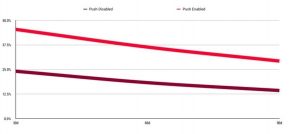Retailers ate losses of more than $ 45 billion thanks to shrinkage in 2015, a $ 1 billion jump from the 2014 total. If this trend continues, the 2016 figure could exceed $ 47 billion!
How can so much inventory just walk out the door? According to the National Retail Federation, there are five main ways for your supply to disappear.
Sometimes it doesn’t even make it to the store. Roughly seven percent of shrink comes from the vendors in the form of overcharges or undersupply. Small businesses can be especially vulnerable to this if they operate on more informal bases with their supply companies. Check your contracts and make sure expectations are clear.
Human errors count for another 16 percent. Maybe someone ordered too much product to move in a realistic timeframe. A stocker accidentally slapped the wrong price on an item and led to an impromptu sales event. It could be something as simple as poorly-inventoried stockrooms that harried employees tally by physical count and tally marks.
Other times, though, goods may get a helping hand out the door.
Shoplifting counts for 38 percent of loss. People may steal for personal use. They might need to make fast money from a resale. It could be nothing more than they steal because they can, but the end result remains the same: Lost revenue and unbalanced books.
Employee theft comes in as the second largest cause at 35 percent. You never want to believe someone you trusted to work in your business would ever steal from it, but disgruntled personnel could see it as a way to get back at the boss. A “discount” on something could be an attempt to woo a potential sweetheart.
Both shoplifting and employee theft share a common trait: Smaller thefts often go unnoticed. Even when the discrepancies are found out, it isn’t difficult to explain away how a few things here and there “fell behind a shelf” or “must not have been logged correctly.”
The remaining four percent don’t fall into any of these categories and are generally chalked up to “acts of God” or left as unsolved mysteries. You can only do so much to combat the last group: Insurance, smoke detectors, and a healthy dose of luck play as much of a role in loss prevention as anything else. That still leaves 96 percent. What can you do to keep your shrink down (and your doors open)?
Know those who fill your storerooms
You want to trust the people you patron for your supplies just as you want your customers to trust you. You want fair deals for your money and to receive that for which you paid. But can you always trust when someone tells you, “Hey, I know a guy…”?
No.
Ask around and see if any of your colleagues do or did business with the vendors you are checking out. Look up their credentials and business standings through any regulatory offices in their local area. Hit the Internet and look over Yelp, Google, and general search engine results to get a feel for interaction histories.
Also make sure to check for any potential conflicts of interest that might pop up on your end. Did any of your employees work for this vendor or deal with it in the past?
Once you decide to partner with a particular vendor, make sure you spell out your needs and the agreed rates in your contract. If the representative tries to dissuade this step, look elsewhere for your stock.
Track your inventory from the moment it arrives to the time it leaves
Take the plunge and invest in an inventory management system. The savings from reduced shrinkage and more accurate supply orders will quickly make up for the expenditure on the equipment and software. You will be able to maintain a real-time account of what remains in stock with each pulled truck or sale made.
Each employee can use a unique identifier that points out who logged supplies in, scanned a product, or, in less positive lights, seems to report more discrepancies in their counts.
Another benefit of automated tracking is the reduced potential for human error. Each unique barcode identifies a particular item and is logged on the central database. You can customize your particular logs to include how many items you possess, when the last one moved, who moved it, and the inventorying employee. Any mistakes can be quickly identified and remedied without complicated, inefficient spreadsheets or eye-blurring, mind-numbing hand counts.
If cost remains a concern, take a look at mobile apps that can help ease you into the automated realm. Some are even free!
Remember: It all comes down to people
No matter what measure you take to keep tabs on your inventory, it all comes down to your people. You can install cameras, but you can’t eliminate every blind spot. You can point out how shrinkage will deminish your company’s profits and your employees’ paychecks. And you can invest in inventory management software and train your people to use it properly. You can beat the shrinkage.
How does shrinkage affect your business? What steps did you take to combat it?
Business & Finance Articles on Business 2 Community(92)







